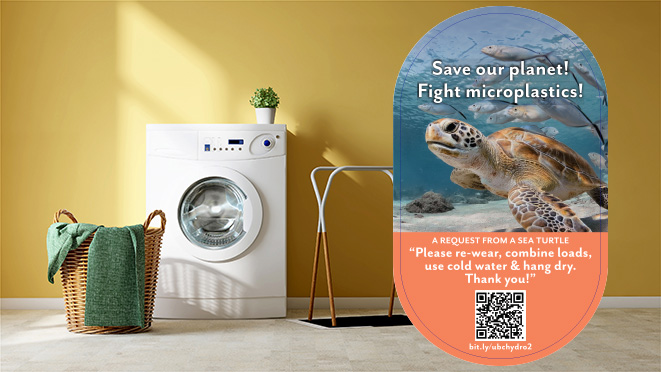Microplastic pollution from laundry? What we all learned

Team Power Smart members can grab a free laundry kit, join the fight
What does it take to nudge people in B.C. to adopt energy efficient laundry habits?
According to UBC's Decision Insights for Business & Society, the path to change isn't always around energy cost savings or carbon emission reductions. At least with Team Power Smart members, the messaging that most drives energy efficient laundry behaviours focuses on the link between laundry and the generation of microplastics affecting turtles and other sea life.
Did you know that a single load of laundry – when machine washed in hot water and machine dried with hot air – produces between 700,000 and 12 million microfibres that wind up in our oceans? It's estimated that laundry is responsible for 35% of microplastics in oceans, and that there are relatively easy ways to reduce that number:
- Re-wear clothes until they're dirty
- Combine loads to run fewer, larger loads of laundry
- Wash laundry in cold water
- Hang-dry laundry inside or outside, as much as possible
"We found that [learning about] microplastics and laundry was something that was new to people," said Dave Hardisty, Associate Professor of Marketing and Behavioural Science at UBC and the lead researcher in the study conducted in 2022. " It was novel, and as a strong motivator it was the best thing we found for changing laundry behaviour."
Why do microplastics matter? According to the United Nations Environment Programme (UNEP), microplastics ingested by marine life such as birds, fish, mammals, and plants have both toxic and mechanical effects. They can lead to reduced food intake, suffocation, behavioural changes, and genetic alteration.
They can also wind up in our bodies, mainly through ingestion of seafood. The UNEP reports that microplastics have been found in various human organs, and even in the placenta of newborn babies.
Log into your Member Tool Box, claim your laundry kit
To help Team Power Smart members adopt energy-efficient laundry habits that help reduce related microplastics, we're giving away a free laundry kit this month to the first 10,000 Team Power Smart members who claim the kit by logging into their Member Tool Box. Included in the kit are a magnet with messaging to help remind you how to minimize how much microplastics you produce when doing laundry, plus a four-pack of branded clothes pins and a four-pack of laundry detergent strips.
Not a Team Power Smart member? Join for free today, then log in to your Member Tool Box.
Messaging drives change, with an assist from a turtle
On the phone from Italy, UBC's Hardisty cautioned that messaging that works for many Team Power Smart members isn't guaranteed to resonate with the broader public. As a Team Power Smart member, you're not a typical consumer.
"We were really impressed with the engagement of Team Power Smart members," said Hardisty. "People were really taking it seriously. We got a lot of emails from people, a lot of ideas from them, and that was nice. Often times we do surveys online where you get a lot of people who don't really care. These people care."
The titles of behavioural studies don't typically just roll off the tongue, and this project conducted by Team Power Smart and UBC's Sauder School of Business was no exception. But don't let A Longitudinal Field Study of Separate vs. Combined Nudges for Household Laundry Behaviours scare you off. There's some intriguing stuff here.
Before the main study began, Hardisty and his UBC team first pre-tested what they thought would be some potentially valuable "nudges" around financial motivations and climate change. But even after presenting some big potential dollar savings numbers around washing and drying laundry (cold water, fewer loads, hang-drying, etc.), and producing potential CO2 emissions savings, folks wouldn't budge.
"I thought the financial stuff would be the most effective because people care about money," says Hardisty. "But none of it really worked. And my best guess is that many Canadians are energy wise, and that we weren't telling them anything they didn't already know. They care about saving energy and already know that energy costs money."
Ditto for climate action, which given BC Hydro's 98% clean energy, was an even harder sell. So it was time to try something new.
Initially, when asked about microplastics, people showed little interest. But once they were informed of the link between laundry and microplastics in oceans – and reminded by messaging on a laundry-area decal that featured a turtle image – everything changed.
What does this mean for you as a Team Power Smart member? If you weren't in the study, learning more about the link between laundry and microplastics – and possibly adding a reminder of that in your laundry room, could help you change your laundry behaviours.
Related:
- Your laundry shed harmful microfibers. Here's what you can do about it (nytimes.com)
- Your laundry and microplastics pollution (CBC's Quirks & Quarks)
- How to reduce microplastics in laundry (Popular Science)